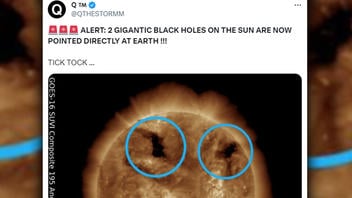
Does an image of the sun posted on X show two black holes pointed directly at Earth? No, that's not true: The dark areas in the image are coronal holes made visible with a Solar Ultraviolet Imager on the GOES-16 satellite, and they are not "black holes." Coronal holes do have the potential to produce geomagnetic storms, rated from one to five in severity. The space weather conditions at the time this image was made were rated as none at all to minor, at one, the lowest on the scale.
The alarmist claim appeared in a post (archived here) on X, formerly Twitter, by @QTHESTORM on January 23, 2024. It was captioned:
🚨🚨🚨 ALERT: 2 GIGANTIC BLACK HOLES ON THE SUN ARE NOW POINTED DIRECTLY AT EARTH !!!
TICK TOCK ...
This is what the post looked like on X at the time of writing:
Lead Stories contacted Dean Pesnell, project scientist of the Solar Dynamics Observatory within NASA's Heliophysics Division, to ask what this image shows. He emailed on January 25, 2024, identifying the dark spots as coronal holes:
The implication of the post is that some bad thing is about to happen. That is not true. Any material from coronal holes that gets near the Earth is absorbed into the outer regions of the Earth's magnetic field (called the magnetosphere.) We study this magnetospheric response to learn how electrons are accelerated far above the Earth and are then stopped by the Earth's upper atmosphere. The NOAA Space Weather scales at https://www.swpc.noaa.gov all say low levels of activity are present and predicted for ... 24 hours.
The dark spots in the pictures are not black holes, they are coronal holes, which the National Oceanic and Atmospheric Administration (NOAA) describes this way:
Coronal holes appear as dark areas in the solar corona in extreme ultraviolet (EUV) and soft x-ray solar images. They appear dark because they are cooler, less dense regions than the surrounding plasma and are regions of open, unipolar magnetic fields. This open, magnetic field line structure allows the solar wind to escape more readily into space, resulting in streams of relatively fast solar wind and is often referred to as a high speed stream in the context of analysis of structures in interplanetary space.
The image pictured in the post on X has timestamp information in white text on the left side that says:
GOES-16 SUVI Composite 195 Angstroms 2024-01-23 22:56:34
GOES stands for Geostationary Operational Environmental Satellites, and SUVI is the Solar Ultraviolet Imager. A space telescope can pick up ultraviolet photons that can not penetrate Earth's atmosphere. NOAA has a Space Weather Prediction Center where a live image of the sun and the current space weather conditions can be found. The image appearing in the post on X appears to have originated from this swpc.noaa.gov website, but has since been rotated 90 degrees clockwise.
(Source: Lead Stories composite image with X and archive.org screenshots taken on Thu Jan 25 22:47:52 2024 UTC)
The Lead Stories composite image above shows how the 2024-01-23 22:56:34 image of the sun in the post on X compares to an image archived about 17 hours earlier at 2024-01-23 05:40:32. Although not taken at the same time, the general size and position of the coronal holes is fairly consistent. The site shows six images (not pictured here) of the sun's ultraviolet wavelengths from 94 to 304 angstroms. As noted in the white text, the solar image in question shows the ultraviolet light from the 195 angstrom wavelength, which is the wavelength where the coronal holes show up with the most contrast.
The image below shows a detail of the January 23, 2024, archived page, including the 24-hour observed maximums, the latest observed conditions and the prediction from two days earlier. A separate page explains the scale system. The letters R, S, and G represent Radio Blackouts, Solar Radiation Storms and Geomagnetic Storms. The green squares show no space weather conditions affecting people. The yellow squares marked R1 show a minor impact on high-frequency (HF) radio communication:
HF Radio: Weak or minor degradation of HF radio communication on sunlit side, occasional loss of radio contact.
Navigation: Low-frequency navigation signals degraded for brief intervals.
(Source: archive.org screenshot taken on Thu Jan 25 22:47:52 2024 UTC)


















